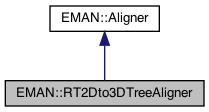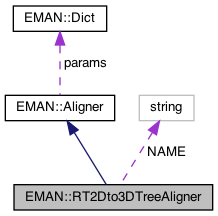Alignment of a 2D image into a 3D volume using a hierarchical method with gradually decreasing downsampling in Fourier space. More...
#include <aligner.h>


Public Member Functions | |
| virtual EMData * | align (EMData *this_img, EMData *to_img, const string &cmp_name="sqeuclidean", const Dict &cmp_params=Dict()) const |
| See Aligner comments for more details. More... | |
| virtual EMData * | align (EMData *this_img, EMData *to_img) const |
| See Aligner comments for more details. More... | |
| virtual vector< Dict > | xform_align_nbest (EMData *this_img, EMData *to_img, const unsigned int nsoln, const string &cmp_name, const Dict &cmp_params) const |
| See Aligner comments for more details. More... | |
| virtual string | get_name () const |
| Get the Aligner's name. More... | |
| virtual string | get_desc () const |
| virtual TypeDict | get_param_types () const |
 Public Member Functions inherited from EMAN::Aligner Public Member Functions inherited from EMAN::Aligner | |
| virtual | ~Aligner () |
| virtual Dict | get_params () const |
| Get the Aligner parameters in a key/value dictionary. More... | |
| virtual void | set_params (const Dict &new_params) |
| Set the Aligner parameters using a key/value dictionary. More... | |
Static Public Member Functions | |
| static Aligner * | NEW () |
Static Public Attributes | |
| static const string | NAME = "rotate_translate_2d_to_3d_tree" |
Private Member Functions | |
| bool | testort (EMData *small_this, EMData *small_to, vector< float > &s_score, vector< Transform > &s_xform, int i, Dict &upd, Transform initxf, int maxshift, int maxang) const |
Additional Inherited Members | |
 Protected Attributes inherited from EMAN::Aligner Protected Attributes inherited from EMAN::Aligner | |
| Dict | params |
Detailed Description
Alignment of a 2D image into a 3D volume using a hierarchical method with gradually decreasing downsampling in Fourier space.
In theory, very fast, and without need for a "refine" aligner. Comparator is ignored. Uses an inbuilt comparison.
- Parameters
-
sym The symmtery to use as the basis of the spherical sampling verbose Turn this on to have useful information printed to standard out
- Date
- Feburary 2016
Finished by MuyuanChen, 07/2018
Member Function Documentation
◆ align() [1/2]
|
inlinevirtual |
See Aligner comments for more details.
Implements EMAN::Aligner.
Definition at line 1834 of file aligner.h.
References align().
◆ align() [2/2]
◆ get_desc()
|
inlinevirtual |
Implements EMAN::Aligner.
◆ get_name()
|
inlinevirtual |
◆ get_param_types()
|
inlinevirtual |
Implements EMAN::Aligner.
Definition at line 1859 of file aligner.h.
References EMAN::EMObject::BOOL, EMAN::EMObject::FLOAT, EMAN::EMObject::INT, EMAN::TypeDict::put(), EMAN::EMObject::STRING, and EMAN::EMObject::TRANSFORMARRAY.
◆ NEW()
|
inlinestatic |
◆ testort()
|
private |
Definition at line 3339 of file aligner.cpp.
References EMAN::Dict::begin(), EMAN::EMData::calc_ccf(), EMAN::Dict::end(), EMAN::Transform::get_params(), EMAN::Transform::get_trans(), EMAN::Dict::has_key(), EMAN::Transform::inverse(), EMAN::Aligner::params, EMAN::Transform::set_params(), and EMAN::EMData::translate().
Referenced by xform_align_nbest().
◆ xform_align_nbest()
|
virtual |
See Aligner comments for more details.
Reimplemented from EMAN::Aligner.
Definition at line 2998 of file aligner.cpp.
References EMAN::EMData::calc_ccf(), EMAN::Symmetry3D::gen_orientations(), EMAN::Factory< T >::get(), EMAN::EMData::get_clip(), EMAN::Aligner::get_params(), EMAN::Transform::get_params(), EMAN::Transform::get_rotation(), EMAN::Transform::get_trans(), EMAN::Dict::has_key(), InvalidCallException, InvalidParameterException, EMAN::Transform::inverse(), EMAN::Aligner::params, EMAN::Dict::set_default(), EMAN::Transform::set_params(), EMAN::Transform::set_trans(), EMAN::Dict::size(), and testort().
Member Data Documentation
◆ NAME
|
static |
Definition at line 1874 of file aligner.h.
Referenced by get_name().
The documentation for this class was generated from the following files: